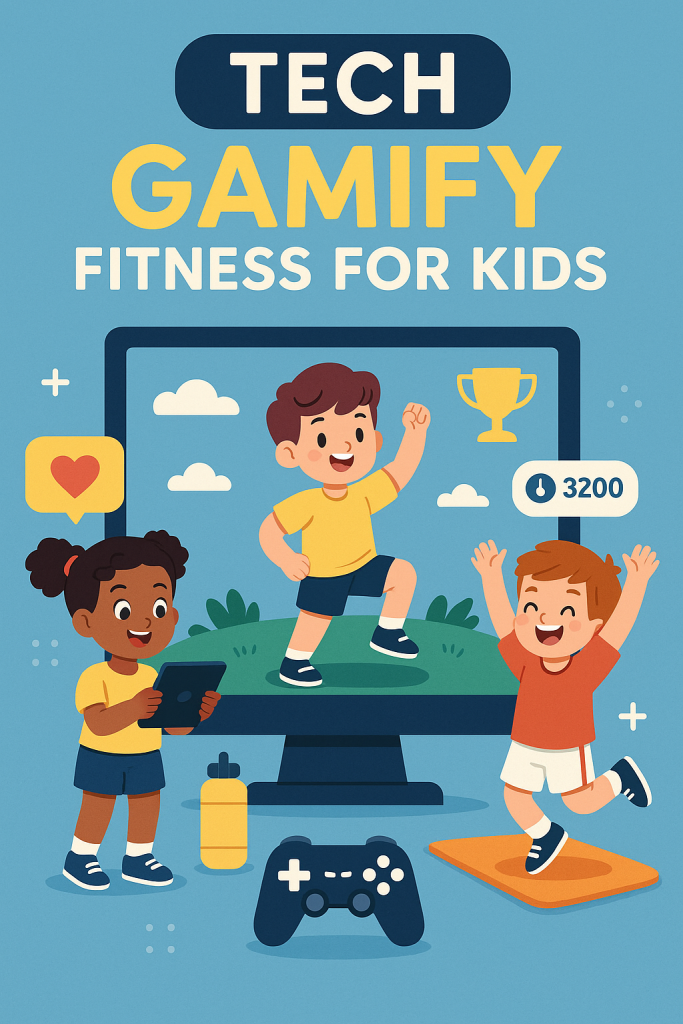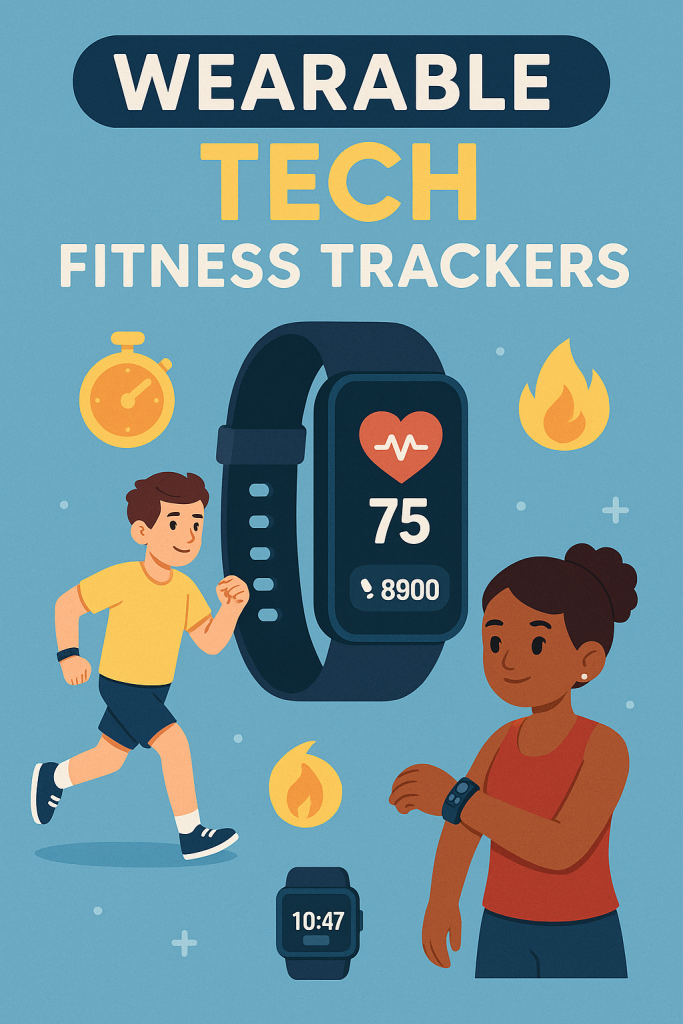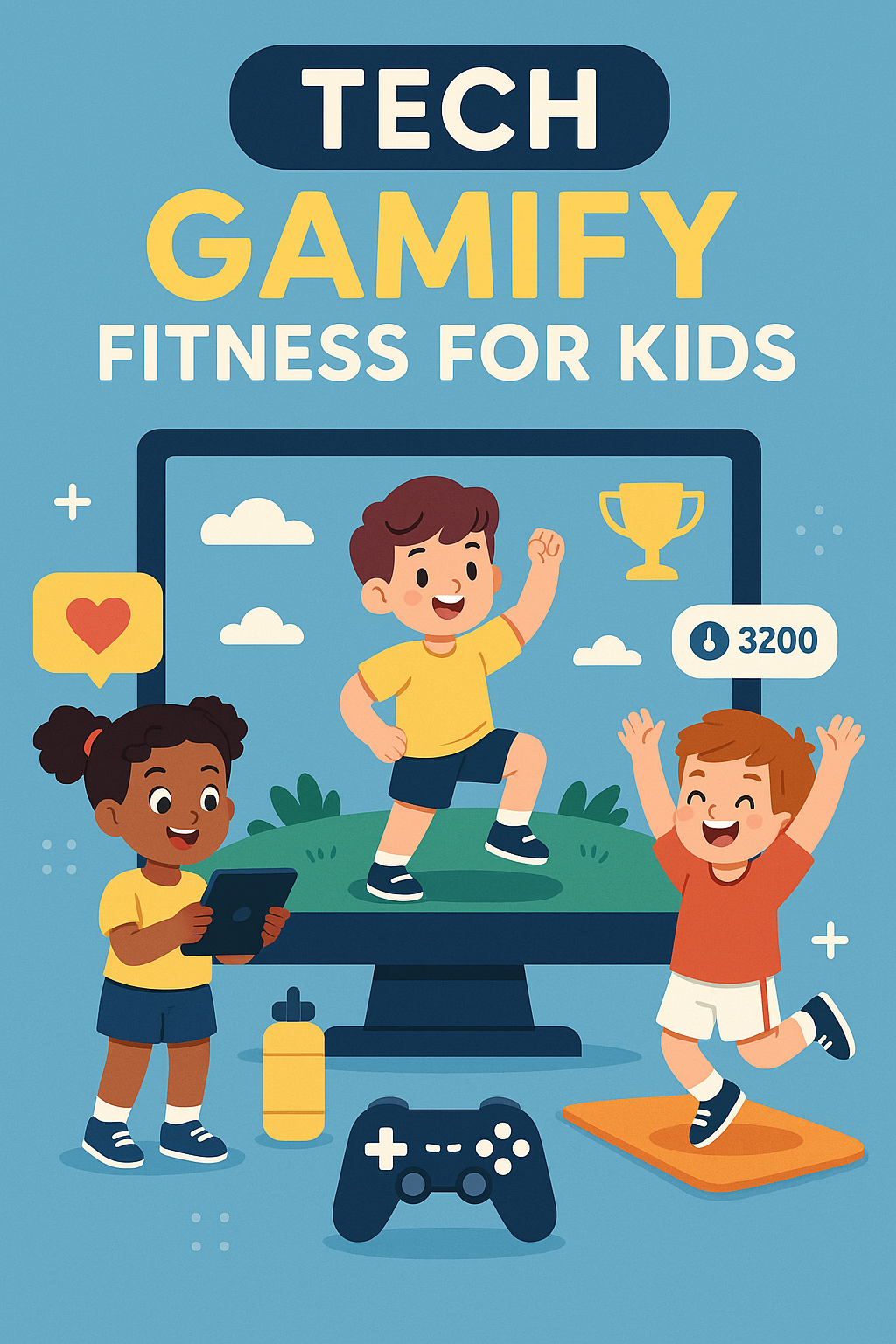
Many kids aren’t naturally drawn to being active, but with the right Tech Gamify Fitness for Kids, they can learn to enjoy it. By turning movement into a game, even those who usually prefer hobbies like art or writing can start to play, exercise, and have fun. I’ve seen children who would despise PE become excited when you introduce something playful.
Whether it’s an outside adventure or a room-based challenge, they begin to involve themselves more. Tech gamify fitness for kids by making it fun and engaging—so even the most reluctant ones start moving without feeling like it’s a chore. With creativity, sports and motion can feel like play, and they start to move without even realizing it’s physical
How Tech Gamify fitness for Kids
Technology and devices use fun tools and platforms to make fitness more engaging for kids. These smart options drive children to make exercise a game, offering a variety of ways to keep kids active and excited. Combining technology with movement helps children enjoy staying healthy naturally.
Wearable Tech gamify Fitness Tracker for kids
When it comes to helping kids stay active, I’ve found that wearable devices like the Garmin Vivofit Jr. 3, Fitbit Ace 3, and Apple Watch SE are great tools. These trackers are designed specifically for children, making it easier to monitor their activity levels, steps, and even sleep patterns. What I really like about them is the gamified features that turn fitness into a fun challenge, encouraging kids to keep moving without feeling like it’s a chore.

- Tokens and Gifts: Kids earn tokens for completing step goals, which can unlock virtual badges or in-app gifts.
- Game Rounds: Are simple tasks that kids complete to earn points, badges, or fun rewards after each level.Like exploring a virtual jungle by completing daily activities.
- Family Control: Parents can monitor growth and set targets to help keep kids motivated.For example, the Garmin Vivofit Jr. 3 gives badges for completing missions, like exploring the “Underwater Kingdom,” turning fitness into a fun journey.
Tech Gamify for kids Fitness Apps
Apps like Pokémon GO, Zombies, Run!, and GoNoodle,Glooko(designed for kids with diabetes) turn exercise into an immersive experience. These apps use stories, fun tasks, and social tools to keep kids active.
- Story-Based Workouts: Zombies, Run! puts kids in a post-apocalyptic setting where running helps them escape zombies, turning cardio into an exciting adventure.
- Team Connection: Apps like Strava let kids join leaderboards and give “likes” to friends, helping them feel connected and part of a fun community
- Adjustable Goals: Kids and parents can create their own fitness goals, like running a set distance or finishing fun daily tasks
Exergames and Consoles Help tech Gamify Fitness for Kids
Exergames are video games that involve physical exercise. Consoles such as the Nintendo Switch (with games like Ring Fit Adventure) and Xbox Kinect provide interactive ways to keep kids active.
- Fitness Quest Game: This Switch game mixes role-playing and exercise, requiring players to squat, jump, and stretch to beat enemies
- Groove and Move Games: Groove and Move Games like Just Dance and Zumba Fitness: World Party inspire kids to dance, boosting their coordination and cardio health.
- Virtual Reality Workouts: Virtual reality (VR) games like Beat Saber engage kids in high-energy movements, combining fun and fitness.
Augmented Reality Fitness Fun
As a fitness tech educator, I’ve seen how augmented reality (AR) can truly transform how kids view physical activity. Apps like Pokémon Go use AR to motivate children to walk outside, explore the real world, and stay active without even realizing they’re exercising. These games blend virtual and real environments, where players must catch creatures in their surroundings, turning movement into fun and engaging play.
When I introduced Pokémon Go in a kids’ summer camp, their screen time turned into steps tracked by their mobile app, showing how technology can support healthy habits. A 2016 study even showed the game boosted children’s daily physical activity by an average of 20%, proving how effective this form of gamified fitness can be. With clever gameplay and interactive tracking, AR continues to lead a new era of playful, tech-powered wellness.
Benefits of Tech Gamify Fitness for Kids
Integrating fitness technology for children provides many benefits, supported by both research and real-life examples.
Improved Body Activity: A 2023 study revealed that gamified tools boosted children’s step counts by up to 15% compared to regular, non-gamified trackers.
Healthier Mindset: Gamified exercise helps lower stress and anxiety in teens, boosting their emotional strength.
Enhanced Communication Skills: Multiplayer challenges and leaderboards encourage teamwork and friendly competition, helping kids develop enhanced communication skills.
Unique Experiences: Apps and wearables let kids set tailored targets based on their interests, making fitness feel more fun and less like a chore.
For example, Orangetheory Fitness uses heart rate monitors to build a competitive group setting, which can be modified for kids’ fitness classes to promote teamwork.
A Significant Drawback of Tech Gamify Fitness for Kids
When tech gamify fitness for kids, it’s important to consider a significant drawback despite its beneficial effects. Traditional fun games like obstacle courses, nature walks, and tag promote activity, but adding technology often increases screen time. From my experience, kids enjoy the excitement technology brings but sometimes focus more on screens than moving.Parents and teachers should balance technology use with active play to keep kids engaged and healthy
When kids are playing fitness games on an Xbox or following along with workouts on their smartphones, they end up staring at a screen a lot. Even with fun interactive games on smartwatches, the downside is the extra screen time involved in these activities.
Using technology to gamify fitness for kids often leads to increased screen time, which brings several problems. From what I’ve seen, this extra screen exposure causes a shorter attention span and makes kids more irritable. It can also cause physical discomfort like neck pain and shoulder pain from sitting too long. The constant exposure to harmful blue light from screens adds to these issues and may trigger behavioral problems. These effects show why it’s important to control screen time when combining tech and fitness for children.
kids who participate in gamified fitness routines can spend too much screen time. From my experience, setting a time limit keeps them engaged while avoiding negative effects on their eyes. Using blue light glasses or filters helps protect kids’ eyes from strain caused by screens. It’s best to limit screen use to keep fitness fun and safe.
Choose the Best Games
As a parent and someone who’s explored a lot of tech Gamify fitness for kids, I’ve learned that choosing the right games and consoles can truly transform how kids see exercise. When technology is used to gamify movement, fitness feels more like fun than a routine. The key is to make smart choices—pick a game or console that gets children involved in physical activity rather than just sitting still. These interactive tools don’t just encourage motion—they make it exciting and natural for kids to stay active.
Here are some great console choices to get you started:
- Nintendo Switch: with games like Ring Fit Adventure and Just Dance
- Xbox One with Kinect: featuring Kinect Sports Rivals and Shape Up
- Nintendo Wii: with classics like Wii Sports and Wii Fit Plus
- Quell Fitness Gaming Console:, designed for immersive, resistance-based workouts
- VR Headsets: (like Meta Quest) with games such as Beat Saber, Supernatural, and FitXR
How Parents Can Find the Best tech Gamify Fitness Tools for kids
Choosing the best gamified fitness apps or devices for kids needs careful thought. Here is a simple step-by-step guide for parents.
- Understand Your Child’s Interests: Does your child enjoy gaming, storytelling, or competing? Pick tools that match their likes “for example, AR games for explorers or leaderboards for competitive kids”.
- Look for Age-Appropriate Choices: Make sure apps and devices suit your child’s age. For example, the Garmin Vivofit Jr. 3 is perfect for kids aged 4-12.
- Test Before You Purchase: Go to stores to try wearables or download free app trials to check if your child enjoys them.
- Define Clear Goals: Help your child set reachable fitness goals, such as walking 5,000 steps a day or finishing a weekly challenge.
- Keep Track of Progress: Use parental dashboards to monitor activity and make sure the tool stays motivating for your child.
How to Sustain Engagement Over Time
To keep kids interested in tech and gamified fitness, parents and developers can use these strategies.
Switch Up Activities: Alternate between apps, games, and outdoor challenges to keep activities exciting.
Include Family and Friends: Set up family fitness challenges or invite friends to join leaderboards to build a sense of community.
Recognize Achievements: Give kids non-digital rewards, like a park visit, for reaching their fitness goals.
Refresh Content: Pick apps that update often with new levels or challenges to keep excitement high.
The Future of tech Gamify Fitness for Kids
The future of tech Gamify fitness for kids is bright with AI-driven personal trainers and augmented reality workouts that make exercise fun and immersive. Gamified eSports leagues and other emerging trends help kids stay active by making fitness a seamless and personalized part of their lives. As technology keeps evolving, these tools create exciting ways for children to enjoy workouts and develop healthy habits.
For example “With AI-driven trainers, a child can get a workout plan that fits their pace, while augmented reality games turn running and jumping into fun challenges. Gamified eSports leagues let kids compete and stay motivated, making fitness feel like play”.
FAQS
What Is Gamify Fitness for Kids?
Gamification uses points, badges, leaderboards, and challenges to make activities fun. In tech gamify fitness for kids, apps, wearables, and interactive games turn exercise into play. Kids can enjoy virtual quests, compete with friends, or care for digital pets by staying active.
This fitness technology taps into kids’ love for games and technology, with smartwatches rewarding steps and augmented reality (AR) games encouraging outdoor movement, changing how kids view fitness.
Why Gamify Fitness Matters for Kids?
Gamify fitness matters for kids because it makes exercise fun and engaging. By turning workouts into games with challenges, points, and rewards, kids stay motivated to be active. This helps build healthy habits early while using technology they enjoy, making fitness feel like play instead of a chore.
Which Android apps help gamify workouts for kids?
Apps like Zombies, Run!, Pokémon Go, and Sworkit Kids are great Android options that make workouts fun for children. These apps use storytelling, rewards, and challenges to turn exercise into play. This is exactly how Tech Gamify Fitness for Kids—by blending movement with engaging game elements.
How to Gamify Walking?
To Tech Gamify Fitness for Kids, turn walking into a fun game by setting step challenges, using apps with rewards, and adding friendly competitions. This makes walking exciting and motivates kids to stay active daily while tracking progress with wearable devices. Simple goals and digital prizes keep them engaged, healthy, and eager to move more every day.
Conclusion
Starting with the right tech Gamify fitness tools and strategies can make a huge difference in keeping kids moving and excited about fitness. Using popular gamify fitness apps like Fitbit Ace, Pokémon Go, or Ring Fit Adventure turns exercise into a favorite game, helping children enjoy every step, jump, or dance they take. From my experience, when kids see fitness as fun and adventurous, rather than a chore, they naturally develop healthy habits and a more active lifestyle.
Parents play a crucial role by encouraging their child through challenges while managing screen time and privacy carefully. This balance supports not only the physical but also the mental health and social skills of kids, which are essential for long-term engagement. The combination of wearables, apps, and exergames with AR creates a dynamic environment where kids can grow healthier and happier every day.
Seeing the positive changes in my own family has convinced me that gamified fitness is a powerful tool for improving overall physical activity and fostering joy in movement.

